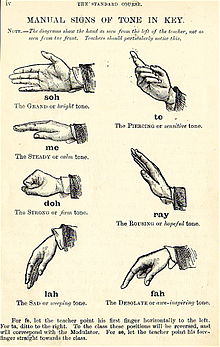In Western musical notation, a key signature is a set of sharp, flat, or rarely, natural symbols placed on the staff at the beginning of a section of music. The initial key signature in a piece is placed immediately after the clef at the beginning of the first line. If the piece contains a section in a different key, the new key signature is placed at the beginning of that section.

Musical notation is any system used to visually represent music. Systems of notation generally represent the elements of a piece of music that are considered important for its performance in the context of a given musical tradition. The process of interpreting musical notation is often referred to as reading music.
In music, notes are distinct and isolatable sounds that act as the most basic building blocks for nearly all of music. This discretization facilitates performance, comprehension, and analysis. Notes may be visually communicated by writing them in musical notation.
In music theory, a scale is "any consecutive series of notes that form a progression between one note and its octave", typically by order of pitch or fundamental frequency.
C or Do is the first note of the C major scale, the third note of the A minor scale, and the fourth note of the Guidonian hand, commonly pitched around 261.63 Hz. The actual frequency has depended on historical pitch standards, and for transposing instruments a distinction is made between written and sounding or concert pitch. It has enharmonic equivalents of B♯ and D.
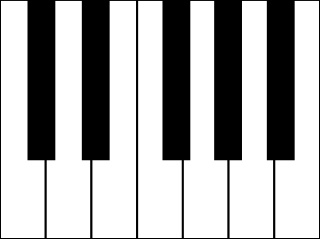
The chromatic scale is a set of twelve pitches used in tonal music, with notes separated by the interval of a semitone. Chromatic instruments, such as the piano, are made to produce the chromatic scale, while other instruments capable of continuously variable pitch, such as the trombone and violin, can also produce microtones, or notes between those available on a piano.
In music, solfège or solfeggio, also called sol-fa, solfa, solfeo, among many names, is a mnemonic used in teaching aural skills, pitch and sight-reading of Western music. Solfège is a form of solmization, though the two terms are sometimes used interchangeably.

"Ut queant laxis" or "Hymnus in Ioannem" is a Latin hymn in honor of John the Baptist, written in Horatian Sapphics with text traditionally attributed to Paulus Diaconus, the eighth-century Lombard historian. It is famous for its part in the history of musical notation, in particular solmization. The hymn belongs to the tradition of Gregorian chant.

Shape notes are a musical notation designed to facilitate congregational and social singing. The notation became a popular teaching device in American singing schools during the 19th century. Shapes were added to the noteheads in written music to help singers find pitches within major and minor scales without the use of more complex information found in key signatures on the staff.
In music, ear training is the study and practice in which musicians learn various aural skills to detect and identify pitches, intervals, melody, chords, rhythms, solfeges, and other basic elements of music, solely by hearing. Someone who can identify pitch accurately without any context is said to have perfect pitch, while someone who can only identify pitch provided a reference tone or other musical context is said to have relative pitch. Someone that can't perceive these qualities at all is said to be tone deaf. The application of this skill is somewhat analogous to taking dictation in written/spoken language. As a process, ear training is in essence the inverse of reading music, which is the ability to decipher a musical piece by reading musical notation. Ear training is typically a component of formal musical training and is a fundamental, essential skill required in music schools and the mastery of music.

In music, letter notation is a system of representing a set of pitches, for example, the notes of a scale, by letters. For the complete Western diatonic scale, for example, these would be the letters A-G, possibly with a trailing symbol to indicate a half-step raise or a half-step lowering. This is the most common way of specifying a note in speech or in written text in English or German. In Germany, Scandinavia, and parts of Central and Eastern Europe, H is used instead of B, and B is used instead of B♭. In traditional Irish music, where almost all tunes are restricted to two octaves, notes in the lower octave are written in lower case while those in the upper octave are written in upper case.
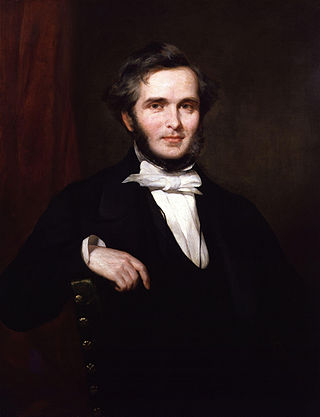
John Curwen was an English Congregationalist minister and diffuser of the tonic sol-fa system of music education created by Sarah Ann Glover. He was educated at Wymondley College in Hertfordshire, then Coward College as that institution became known when it moved to London, and finally University College London.
The numbered musical notation is a cipher notation system used in mainland China, Taiwan, Hong Kong, and to some extent in Japan, Indonesia, Malaysia, Australia, Ireland, the United Kingdom, the United States and English-speaking Canada. It dates back to the system designed by Pierre Galin, known as Galin-Paris-Chevé system. It is also known as Ziffernsystem, meaning "number system" or "cipher system" in German.
Musica ficta was a term used in European music theory from the late 12th century to about 1600 to describe pitches, whether notated or added at the time of performance, that lie outside the system of musica recta or musica vera as defined by the hexachord system of Guido of Arezzo.
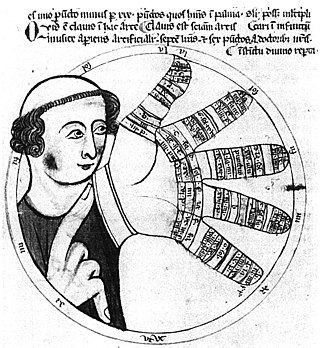
Solmization is a mnemonic system in which a distinct syllable is attributed to each note of a musical scale. Various forms of solmization are in use and have been used throughout the world, but solfège is the most common convention in countries of Western culture.

The Guidonian hand was a mnemonic device used to assist singers in learning to sight-sing. Some form of the device may have been used by Guido of Arezzo, a medieval music theorist who wrote a number of treatises, including one instructing singers in sightreading. The hand occurs in some manuscripts before Guido's time as a tool to find the semitone; it does not have the depicted form until the 12th century. Sigebertus Gemblacensis in c. 1105–1110 did describe Guido using the joints of the hand to aid in teaching his hexachord. The Guidonian hand is closely linked with Guido's new ideas about how to learn music, including the use of hexachords, and the first known Western use of solfège.
The Kodály method, also referred to as the Kodály concept, is an approach to music education developed in Hungary during the mid-twentieth century by Zoltán Kodály. His philosophy of education served as inspiration for the method, which was then developed over a number of years by his associates. In 2016, the method was inscribed as an item of UNESCO Intangible Cultural Heritage.
Reverend John Tufts was an early American music educator.
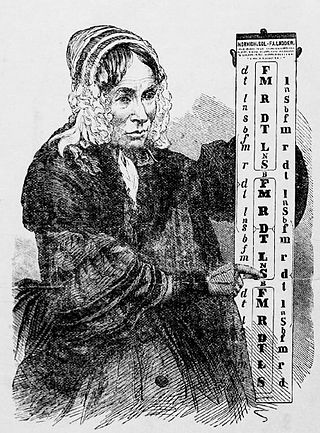
Sarah Anna Glover was an English music educator who invented the Norwich sol-fa system. Her Sol-fa system was based on the ancient gamut; but she omitted the constant recital of the alphabetical names of each note and the arbitrary syllable indicating key relationship, and also the recital of two or more such syllables when the same note was common to as many keys. The notes were represented by the initials of the seven syllables, C, D, E, F, S, L, T; still in use today as their names.

Systems of musical notation have been in use in China for over two thousand years. Different systems have been used to record music for bells and for the Guqin stringed instrument. More recently a system of numbered notes (Jianpu) has been used, with resemblances to Western notations.

